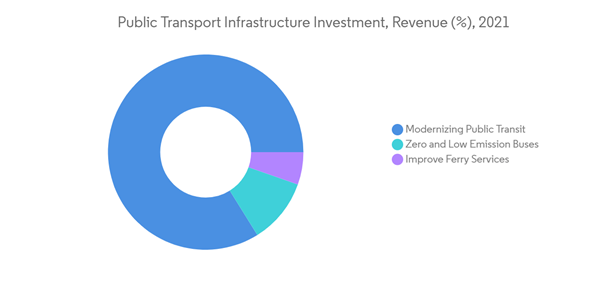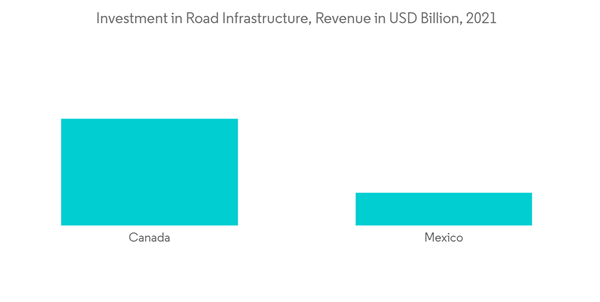Key Highlights
- The North American transportation infrastructure construction market is expected to record a CAGR of more than 5% during the forecast period.
- COVID-19 impacted the transportation sector. The impact is in direct and indirect ways, such as reduction in transit services, slowing down of construction works due to social distancing, and disrupted supply chain. However, the sector is recovering and focusing on developments.
- Transportation infrastructure facilitates the movement of public and goods in the country. Furthermore, an increase in urban mobility creates demand for the construction of more transportation projects.
- Roadways are one of the major means of transportation in North America, followed by railways. For instance, the US government has financed more than 300,000 miles (483,000 km) of transcontinental highways, including more than 40,000 miles (64,000 km) of limited-access multilane roads. Canada offers a coast-to-coast route, while Mexico’s highways link the countries.
- The transportation infrastructure is driven by modernization, which involves reforming railways and improving and rebuilding roads, bridges, airports, etc. This factor resulted in uninterrupted transit and freight services directly contributing to the region’s economy.
Key Market Trends
Increasing Infrastructure Activities in the United States
- Investments are being made to increase the transportation infrastructure activities and improve existing infrastructures, such as extending the roads and rails, planning new construction across the country, and improving damaged structures.
- In 2021, the President of the United States signed Bipartisan Infrastructure Deal, which grants USD 550 billion for new federal investments in the country's infrastructure.
- More than USD 110 billion is allocated to public transport infrastructure from this budget to improve the living standards of the public by providing access to safe, clean, and reliable transportation.
- The increasing infrastructure activities include modernizing the public transportation services, delivering zero and low emissions buses, reforming the rail services (both passenger and freight), and initiating safety programs to cut down accidents and fatalities.
Increasing Investments in Road Infrastructure Construction
- The construction of roadways is one of the main sectors of transportation infrastructure. Public transit using roadways generates more economy.
- Mexico invested in 16 projects, accounting for nearly USD 4.6 billion. These projects include the construction of road infrastructure, highway projects, interchanges, etc.
- Furthermore, in Mexico, the Cuapiaxtla-Cuacnopalan highway (worth USD 209 million) and the Altar-Sásabe highway (worth USD 230 million) were set to start in Q1 2021.
- The Canadian government plans for a long-term investment in unspecified public transportation over ten years.
- Moreover, the United States accounts for the highest rate of investments in road transportation construction and street project spending.
Competitive Landscape
The North American transportation infrastructure construction market is moderately consolidated, as most of the projects are owned by major players in the industry. Hence, small-scale players have less scope. Some of the major players include Obrascon Huarte Lain SA (Ohla), Kiewit Corporation, ACS Actvidades de Construcción y Servicios SA, VINCI Construction, Kraemer North America, and GLOBALVIA Inversiones SAU.
Additional Benefits:
- The market estimate (ME) sheet in Excel format
- 3 months of analyst support
This product will be delivered within 2 business days.
Table of Contents
Companies Mentioned (Partial List)
A selection of companies mentioned in this report includes, but is not limited to:
- OBRASCON HUARTE LAIN SA (OHLA)
- ACS, Actividades de Construccin y Servicios SA
- Kiewit Corporation
- Bechtel Corporation
- CK Hutchison Holdings Limited
- GLOBALVIA Inversiones SAU
- VINCI Construction
- Balfour Beatty
- Kraemer North America
- BOUYGUES CONSTRUCTION SA
- L&T Construction










